I have trained my models by calling the 'train_neural_network' function which trains the model and I store the model, the accuracy comes to around 83%, the problem I'm facing is how do I make predictions using my saved model? Which variable to restore and how to pass the input(in batches or whole at once)?
def make_model(data,train_x):
n_nodes_hl1 = 2000
n_nodes_hl2 = 2000
n_nodes_hl3 = 2000
n_classes = 2 # No of classification
hidden_1_layer = {'weights': tf.Variable(tf.truncated_normal([len(train_x[0]), n_nodes_hl1], stddev=0.1),name= 'weights'),
'biases': tf.Variable(tf.constant(0.1, shape=[n_nodes_hl1]),name = 'biases')}
hidden_2_layer = {'weights': tf.Variable(tf.truncated_normal([n_nodes_hl1, n_nodes_hl2], stddev=0.1),name= 'weights'),
'biases': tf.Variable(tf.constant(0.1, shape=[n_nodes_hl2]),name = 'biases')}
hidden_3_layer = {'weights': tf.Variable(tf.truncated_normal([n_nodes_hl2, n_nodes_hl3], stddev=0.1,),name= 'weights'),
'biases': tf.Variable(tf.constant(0.1, shape=[n_nodes_hl3]),name = 'biases')}
output_layer = {'weights': tf.Variable(tf.truncated_normal([n_nodes_hl3, n_classes], stddev=0.1),name= 'weights'),
'biases': tf.Variable(tf.constant(0.1, shape=[n_classes]),name = 'biases'), }
layer_1 = tf.add(tf.matmul(data, hidden_1_layer['weights']), hidden_1_layer['biases'])
# now goes through an activation function - sigmoid function
layer_1 = tf.nn.relu(layer_1)
print ("Layer 1 done!!")
# input for layer 2 = result of activ_func for layer 1
layer_2 = tf.add(tf.matmul(layer_1, hidden_2_layer['weights']), hidden_2_layer['biases'])
layer_2 = tf.nn.relu(layer_2)
print ("Layer 2 done!!")
layer_3 = tf.add(tf.matmul(layer_2, hidden_3_layer['weights']), hidden_3_layer['biases'])
layer_3 = tf.nn.relu(layer_3)
print ("Layer 3 done!!")
output = tf.matmul(layer_3, output_layer['weights'],name = "output") + output_layer['biases']
return output
def train_neural_network(train_x,train_y,test_x,test_y):
tf.reset_default_graph()
with tf.name_scope('input'):
x = tf.placeholder('float', [None, len(train_x[0])],name= 'x_input')
y = tf.placeholder('float',name = 'y-input')
# Merge all the summaries and write them out to /tmp/mnist_logs (by default)
prediction = make_model(x,train_x)
print ('model ready!!')
with tf.name_scope('pred'):
pred = tf.nn.softmax_cross_entropy_with_logits(logits=prediction, labels=y)
with tf.name_scope('cost'):
cost = tf.reduce_mean(pred)
with tf.name_scope('train'):
optimizer = tf.train.AdamOptimizer().minimize(cost,name = 'optimizer')
tf.summary.scalar("cost", cost)
n_epochs = 10
batch_size = 100
with tf.Session() as sess:
sess.run(tf.global_variables_initializer()) # initializes our variables. Session has now begun.
merged = tf.summary.merge_all()
train_writer = tf.summary.FileWriter('train/2/',
sess.graph)
test_writer = tf.summary.FileWriter('test/')
for epoch in range(n_epochs):
epoch_loss = 0 # we'll calculate the loss as we go
i = 0
while i < len(train_x):
#we want to take batches(chunks); take a slice, then another size)
start = i
end = i+batch_size
batch_x = np.array(train_x[start:end])
batch_y = np.array(train_y[start:end])
_, c = sess.run([optimizer, cost], feed_dict={x: batch_x, y: batch_y})
if i%200 == 0:
train_writer.add_summary(_, i)
epoch_loss += c
i+=batch_size
print('Epoch', epoch, 'completed out of', n_epochs, 'loss:', epoch_loss)
with tf.name_scope('accuracy'):
correct = tf.equal(tf.argmax(prediction, 1), tf.argmax(y, 1))
accuracy = tf.reduce_mean(tf.cast(correct, 'float'))
tf.summary.scalar("accuracy", accuracy)
print('Accuracy:', accuracy.eval({x: test_x, y: test_y}))
saver = tf.train.Saver()
tf_log = 'tf.log'
saver.save(sess, "model3.ckpt")
return accuracy
 This is how I am making predictions, but this fails everytime:
This is how I am making predictions, but this fails everytime:
def test_neural_network(test_x):
batch_size = 100
i = 0
batch_x = np.array(test_x[i:i+batch_size])
tf.reset_default_graph()
x = tf.placeholder('float', [len(batch_x),len(test_x[0])])
y = tf.placeholder('float',[2])
prediction = make_model(x,batch_x)
# pred1 = tf.nn.softmax(logits=prediction)
# weight = tf.get_variable("weights_3", shape=[len(batch_x),2],initializer = tf.zeros_initializer)
saver = tf.train.Saver()
with tf.Session() as sess:
sess.run(tf.global_variables_initializer())
saver.restore(sess, "model3.ckpt")
p = tf.argmax(prediction,1)
print (p.eval({x:batch_x))
gives and array of shape(batch_size,2),expected values [0,1] or [1,0] but getting decimal values.